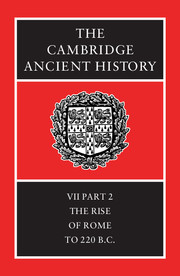Book contents
- Frontmatter
- 1 The Sources for Early Roman History
- 2 Archaic Rome Between Latium and Etruria
- 3 The origins of Rome
- 4 Rome in the fifth century I: the social and economic framework
- 5 Rome in the fifth century II: the citizen community
- 6 Rome and Latium to 390 B.C.
- 7 The recovery of Rome
- 8 The conquest of Italy
- 9 Rome and Italy in the early third century
- 10 Pyrrhus
- 11 Carthage and Rome
- 12 Religion in Republican Rome
- Appendix
- Chronological Table
- BIBLIOGRAPHY
- Index
- Fig. 50:The city of Rome in the early third century b.c.
- Map 11: The western Mediterranean in the third century
- References
4 - Rome in the fifth century I: the social and economic framework
Published online by Cambridge University Press: 28 March 2008
- Frontmatter
- 1 The Sources for Early Roman History
- 2 Archaic Rome Between Latium and Etruria
- 3 The origins of Rome
- 4 Rome in the fifth century I: the social and economic framework
- 5 Rome in the fifth century II: the citizen community
- 6 Rome and Latium to 390 B.C.
- 7 The recovery of Rome
- 8 The conquest of Italy
- 9 Rome and Italy in the early third century
- 10 Pyrrhus
- 11 Carthage and Rome
- 12 Religion in Republican Rome
- Appendix
- Chronological Table
- BIBLIOGRAPHY
- Index
- Fig. 50:The city of Rome in the early third century b.c.
- Map 11: The western Mediterranean in the third century
- References
Summary
THE TWELVE TABLES
The documentation for early Roman social and economic structures is sparse and inadequate. The literary narratives, preoccupied with war and politics, commonly ignore such topics except where they are relevant to their central themes, and even then their lack of detailed information often confines them to speculation or inference from more recent conditions. Archaeology throws some light on contemporary material culture, but its evidence is severely restricted. We lack tombs securely datable to the fifth century, apparently because it was then customary to bury the dead without grave goods, and fifth-century material is also absent from certain major sacral sites, notably the Lapis Niger votive deposit and the Sant’ Omobono sanctuary. Linguistic, religious and other institutional survivals from the early period provide significant clues to particular aspects of both economic and social behaviour but seldom yield a precise context into which these individual items can be placed in terms either of chronology or of overall development. Evidence from other societies presumed to be of a broadly similar character may offer possible models for the reconstruction or interpretation of the Roman evidence and, in the case of the early economy, the known geographical features of the region, together with the limitations on economic development common to ancient societies, supply at least a rudimentary framework for reconstruction. None of this, however, suffices for more than tentative hypothesis, and even then we must often rely partly on inference from later Roman conditions, with the inevitable risk that the distinctive features of sub-archaic society may become blurred or escape detection altogether.
Keywords
- Type
- Chapter
- Information
- The Cambridge Ancient History , pp. 113 - 171Publisher: Cambridge University PressPrint publication year: 1990
References
- 2
- Cited by



